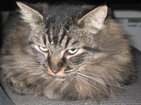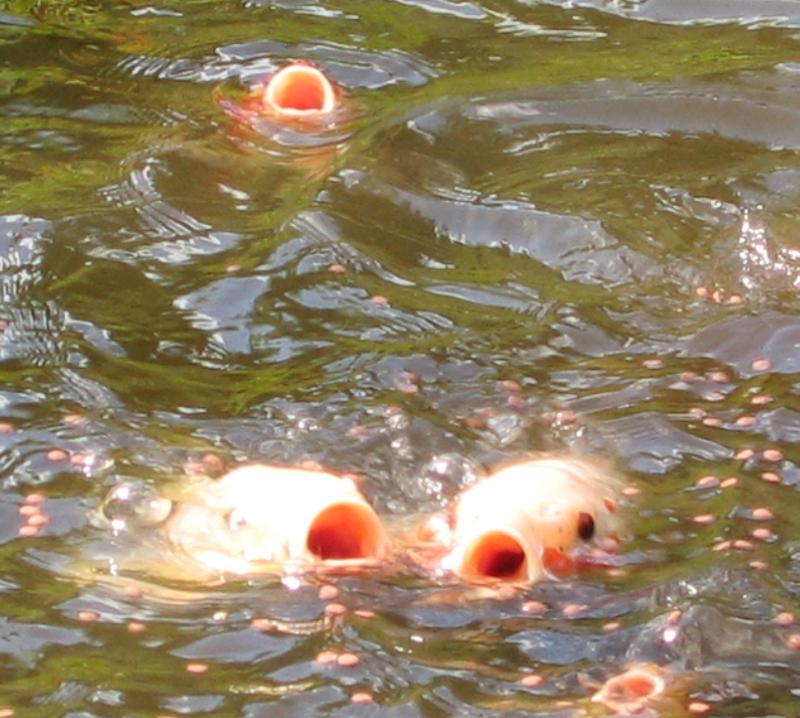|
Tinkerbelle's
Pond Tips
 Tinkerbelle Hughes Tinkerbelle Hughes
Is your pond becoming the neighborhood lunch wagon or a playground for furry and feathered friends? Hughes Water Gardens offers these suggestions:
- Fishing Line for Herons: Criss-cross fishing line above your pond 7 feet or higher with about 3' in between. This will make it harder for humans to see but the heron will be deterred for fear of entanglement.
- Heron Replica (decoy): Herons are a territorial bird and if they think they see another bird they may stay out of the area. Important: The more realistic the replica the better. (Heron are smart and skilled hunters). Regular relocation of the replica is necessary for the same reason.
- Gazing Globes: Non-breakable floating gazing globes are placed in your pond so heron see their reflection. This causes the heron to believe another heron is nearby and leave.
- Pond Dyes: Pond dye not only helps with algae control but it also makes it harder for predators to see your fish. The disadvantage: it is harder for you to see your fish as well! We have black and also blue dye choices that can be very attractive in your pond.
- Construction and Planting Techniques: Making your pond deep with straight sides can help fight predators. Raccoons can swim but prefer not to. Heron generally like wading into the pond. Both prefer an easy lunch. By providing an abundance of plants and or rock caves, your fish can hide. Plants however can become a play toy for raccoons.
- Traps: Humane traps for raccoons can be effective. The question is where do you relocate the animal after you capture them? Your neighbors out in the country will not appreciate any donations.
- Scarecrow: This is a battery powered, motion-activated impact sprinkler. It simply connects to your garden hose. This has been proven effective for both heron and raccoon.
- Hot wire (electric fence): By far the most effective. By placing one or two low voltage wires around the perimeter of your pond you build an almost impenetrable fortress for your valued plants and fish. Of course, there are a couple of downsides (figures!). First if you are not careful humans and pets might experience the low voltage charm. Secondly you will have to adjust to your new visual aesthetics of the pond. In plain language, it just does not look quite as nice.
- Pond & Garden Guard. A motion activated blinking light and buzzer. A new item at Hughes that has been well received by customers.
Still not sure? Come in and the staff at Hughes Water Gardens can assist you.
|
September Classes
Saturday 5th
10 am
Building Ponds & Waterfalls
Saturday 12th
10 am
Pondless Waterfalls & Creeks
2 pm
Pondless Urns & Bubbling Rocks
10 am
Planting Your Pond with Winter Interest Plants
Saturday 26th
10 am
Building Ponds & Waterfalls
Preregistion is requested
All classes are free, 1 to 2 hours long, at our nursery
|
Title Photo by
Sheryl Zimmerman
Image Specialist
|
|
|
|
|
|
|
The Five Senses of Koi
Do Koi Smell?
Whew! Do they! Seriously though, koi do have a very good sense of smell. This extremely acute ability, along with their sense of taste, are the primary ways of finding food in their natural environment. When food dissolves in water it can then be detected by the 'nares' that are located at the base of their nostrils. These nares can be thought of as U-tubes - the water enters through the forward opening and exits through the rear opening.
Why do They Have Whiskers?
These whiskers are called barbels and they have them to help them taste. In a way they are similar to a tongue as they have taste buds on them. Many, many years ago koi had three barbels, but now they only have two. Koi also have taste buds on their mouth and lips, so they have an excellent sense of taste.
Do the Koi Hear....They Have No Ears?
Yes, koi do hear even though they have no external ears. This is accomplished by the koi sensing vibrations in the water. Here is where it gets a little complicated; the koi hear with what is called the Weberian Ossicles, a group of bones that are connected on one end to the forward swim bladder and on the other end to the auditory center, a sensing organ that resembles our inner ear. Koi, like other fish, are very sensitive to sound and can be stressed to the point of becoming ill by loud noises, especially on a constantly recurring basis.
Do the Koi See Very Well?
Koi see exceptionally well. They have such good sight that they could probably even read a book! They actually even have a greater range of vision than we do, as they have bilaterally placed eyes that are independently moveable. They also see in color. Their eyes of the koi are more vulnerable than our eyes as they do not have eyelids, so great care must be taken when they are netted and handled.
Do Koi Have the Sense of Touch?
Yes, and the most sensitive area for this sense is located about midway down the side of the fish called the lateral line. Holes in the scales lead to a canal beneath the surface that contains neuromast cells. Water movement in any direction striking the sides of the fish will cause the mucous in the canal to vibrate. These vibrations stimulate the cells, which are linked to the nerve system, and provides the koi with one of their most effective survival techniques (flight reaction).
Article provided by Linda Montgomery/Cascade Koi Club
|

Feeding Fish
Feeding your fish is one of the most enjoyable aspects of having a pond. There is nothing more gratifying than the fish swimming up to you every time you approach because they know you might have food (it makes you feel loved). By following a few simple rules you can keep your fish very happy and keep the fish waste down.
- #1 Rule do not overfeed your fish-Their small digestive systems are not suited to large meals and if given to much most will pass through undigested. This can pollute the pond and create serious algae and possibly cause fish health problems.
- Feed them only what they will finish in 5 minutes. Do not leave uneaten food in the pond (algae issues - guaranteed).
- Do not feed in the winter. When the water temperature is below 50 degrees it is time to stop feeding them.
- Use a wheat germ based food in the spring and fall.
- Use a higher protein food in the summer.
- Great treats to occasionally feed them are: seedless watermelon, cheerios, oranges or grapefruit halves (de-seeded).
- There are foods that contain color enhancers such as Hai Feng Fast Color. These are usually used in the peak of summer.
- Keep a pond thermometer on hand to check pond water temperature.
|
Two Special Events at Hughes!
Monumental Sculpture of the American West lecture
Sunday August 30, 2009 1:00 - 2:30 pm
"The Rhythms Of Stone"
Garden Sculpture - Water Feature Workshop
September 18-20

Award-winning sculptor DJ Garrity, will lead a fascinating exploration of the art of stone sculpture at Hughes Water Gardens from September 18-20, 2009.
Garrity, who served three tours of duty as the Sculptor-In-Residence of the Mount Rushmore National Memorial, has established an international reputation with his innovative workshop. The artists' refined approach to the expressive qualities of the human face allows the participants to finesse an image from stone, which carries their unique creative imprint.
The workshop is accredited for professional development, graduate or undergraduate credits. Each participant will also have the option of converting their sculpture into a water feature. The workshop fee is $285 and includes materials and use of tools. Space is limited. No previous background in the arts is required and the program is approved by the Oregon State Landscape Contractors Board for continuing education credits (18 CEH) and by Augustana College for Teacher's professional Development.
LCB Continuing Education
Click here to see the class syllabus.
To register for the workshop please contact Hughes Water Gardens, 25289 SW Stafford Road, Tualatin, OR (503) 638-1709 or the artist at (503) 372-6098. More information is available at www.hugheswatergardens.com & www.djgarrity.com.
|
|
Our Mailing Address
25289 SW Stafford Rd, Tualatin, OR 97062
Summer Hours
Monday - Saturday
9 to 6
Sunday
10 to 5
Our Telephone
503-638-1709
Copyright (C) 2008 Hughes Water Gardens. All rights reserved
| |
|
|
|